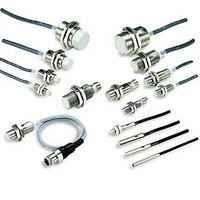E2E2-X5MB1-M1 Omron, E2E2-X5MB1-M1 Datasheet - Page 36

E2E2-X5MB1-M1
Manufacturer Part Number
E2E2-X5MB1-M1
Description
Proximity Sensors E2E2-X5MB1 W/M12
Manufacturer
Omron
Series
E2E2r
Specifications of E2E2-X5MB1-M1
Maximum Operating Temperature
+ 85 C
Supply Voltage
12 V to 24 V
Operating Supply Voltage
12 V to 24 V
Mounting Style
Cylindrical
Minimum Operating Temperature
- 40 C
Maximum Output Current
200 mA
Features
NO
Sensing Distance
5 mm
Sensor Type
Inductive
Sensing Object
Metallic
Response Frequency
400Hz
Material - Body
Nickel-Plated Brass
Shielding
Unshielded
Voltage - Supply
10 V ~ 55 V
Output Type
PNP-NO
Terminal Type
Connector
Package / Case
Cylinder, Threaded - M12
Lead Free Status / RoHS Status
Lead free / RoHS Compliant
Wiring
High-tension Lines
Wiring through Metal Conduit
If there is a power or high-tension line near the cable of the Proximity
Sensor, wire the cable through an independent metal conduit to
prevent against Proximity Sensor damage or malfunctioning.
Cable Tractive Force
Do not pull on cables with tractive forces exceeding the following.
Mounting
The Proximity Sensor must not be subjected to excessive shock with
a hammer when it is installed, otherwise the Proximity Sensor may
be damaged or lose its water-resistivity.
Connecting Load to AC/DC 2-wire Sensor
Refer to the following before using AC or DC 2-wire Proximity
Sensors.
Surge Protection
Although the Proximity Sensor has a surge absorption circuit, if there
is any machine that has a large surge current (e.g., a motor or
welding machine) near the Proximity Sensor, connect a surge
absorber to the machine.
Leakage Current
When the Proximity Sensor is OFF, the Proximity Sensor has
leakage current. Refer to page 17 and page 20 Leakage Current
Characteristics. In this case, the load is imposed with a small voltage
and the load may not be reset. Before using the Proximity Sensor,
make sure that this voltage is less than the load reset voltage. The
AC 2-wire Proximity Sensor cannot be connected to any card-lift-off
relay (e.g., the G2A) because contact vibration of the relay will be
caused by the leakage current and the life of the relay will be
shortened.
Loads with Large Inrush Currents
(E2E-X@T@)
Connecting a load that has a large inrush current (e.g., a lamp or
motor) may result in a malfunction due to the inrush current causing
a load short-circuit.
Countermeasures Against Leakage Current
AC 2-wire Models
Connect a bleeder resistor as the bypass for the leakage current so
that the current flowing into the load will be less than the load reset
current.
As shown in the following diagram, connect the bleeder resistor so
that the current flowing into the Proximity Sensor will be 10 mA
minimum and the residual voltage imposed on the load will be less
than the load reset voltage.
Refer to the following to calculate the bleeder resistance and the
allowable power of the bleeder resistor.
R ≤ V
P > V
36
4 dia. max.
4 dia. min.
S
S
/(10 – I) (k Ω )
2
/R (mW)
Diameter
E2E/E2E2
Bleeder resistor R
Load
Cylindrical Proximity Sensor
30 N max.
50 N max.
Tractive force
VAC power
supply V
S
Environment
Water Resistivity
Do not use the Proximity Sensor underwater, outdoors, or in the rain.
Operating Environment
Be sure to use the Proximity Sensor within its operating ambient
temperature range and do not use the Proximity Sensor outdoors so
that its reliability and life expectancy can be maintained. Although
the Proximity Sensor is water resistive, a cover to protect the
Proximity Sensor from water or water soluble machining oil is
recommended so that its reliability and life expectancy can be
maintained.
Do not use the Proximity Sensor in an environment with chemical
gas (e.g., strong alkaline or acid gasses including nitric, chromic,
and concentrated sulfuric acid gases).
P: The allowable power of the bleeder resistor. (The actual power
I: Load current (mA)
The following resistors are recommended.
100 VAC (supply voltage): A resistor with a resistance of 10 k Ω
maximum and an allowable power of 3 W minimum
200 VAC (supply voltage): A resistor with a resistance of 20 k Ω
maximum and an allowable power of 10 W minimum
If these resistors generate excessive heat, use a resistor with a
resistance of 10 k Ω maximum and an allowable power of 5 W
minimum at 100 VAC and a resistor with a resistance of 20 k Ω
maximum and an allowable power of 10 W minimum at 200 VAC
instead.
DC 2-wire Models
Connect a bleeder resistor as the bypass for the leakage current so
that the current flowing into the load will be less than the load reset
current.
Refer to the following to calculate the bleeder resistance and the
allowable power of the bleeder resistor.
R ≤ V
P > V
P:
i
i
The following resistors are recommended.
12 VDC (supply voltage): A resistor with a resistance of 15 k Ω
maximum and an allowable power of 450 mW minimum
24 VDC (supply voltage): A resistor with a resistance of 30 k Ω
maximum and an allowable power of 0.1 W minimum
R
OFF
:
capacity of the bleeder resistor must be at least a few times as
large as the allowable power of the bleeder resistor.)
: Release current of load (mA)
S
S
The allowable power of the bleeder resistor. (The actual power
capacity of the bleeder resistor must be at least a few times as
large as the allowable power of the bleeder resistor.)
Leakage current of Sensors (mA)
/(i
2
/R (mW)
R
– i
OFF
) (k Ω )
Bleeder resistor R
Load













